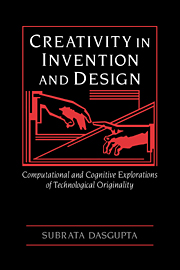Book contents
- Frontmatter
- Contents
- Preface
- Acknowledgments
- Part I Creativity in invention and design: issues and ingredients
- Part II The invention of microprogramming: a cognitive explanation
- 4 Prolegomenon
- 5 The genesis of an idea: creating the initial sketch
- 6 The evolution of an idea: from initial sketch to mature form
- Part III Reflections on the nature of inventing
- Appendix
- References
- Index
5 - The genesis of an idea: creating the initial sketch
Published online by Cambridge University Press: 23 December 2009
- Frontmatter
- Contents
- Preface
- Acknowledgments
- Part I Creativity in invention and design: issues and ingredients
- Part II The invention of microprogramming: a cognitive explanation
- 4 Prolegomenon
- 5 The genesis of an idea: creating the initial sketch
- 6 The evolution of an idea: from initial sketch to mature form
- Part III Reflections on the nature of inventing
- Appendix
- References
- Index
Summary
Problem recognition and formulation
The reader will recall from the section “The concept of creativity” in Chapter 1, that the criteria whereby a cognitive process P is deemed creative pertains to the nature of the product Π of that process. It is quite easy to be seduced into assuming, when we talk about Π, that we are really referring to a solution to some problem. This need not be so. Π may, in fact, itself be a problem and P the process of identifying it.
That the recognition of a problem and its formulation in a tractable or solvable form is one of the characteristic features of the creative mind – at least in the realm of scientific discovery and invention – is widely acknowledged (Sternberg 1988b; Root-Bernstein 1989). In the case of the invention of microprogramming, we have seen, according to the account in Chapter 3, that Wilkes was not presented with an “open” problem – that is, a problem already identified and acknowledged within the relevant community. He saw a problem others had not seen. The problem, it will be recalled, was conceptual in nature, having to do with such attributes as regularity and complexity. And as noted in Chapter 3 (section “On the conceptual nature of Wilkes's problem”), the recognition of such a problem by an individual is frequently inspired by a personal philosophical stance or set of values. This seems to have been the case with Wilkes, for, as he has remarked, it was essentially a “private” problem for him. Thus, at least in the case of microprogramming, problem recognition and formulation may be said to constitute an integral part of the overall concept formation activity.
- Type
- Chapter
- Information
- Creativity in Invention and Design , pp. 103 - 124Publisher: Cambridge University PressPrint publication year: 1994



